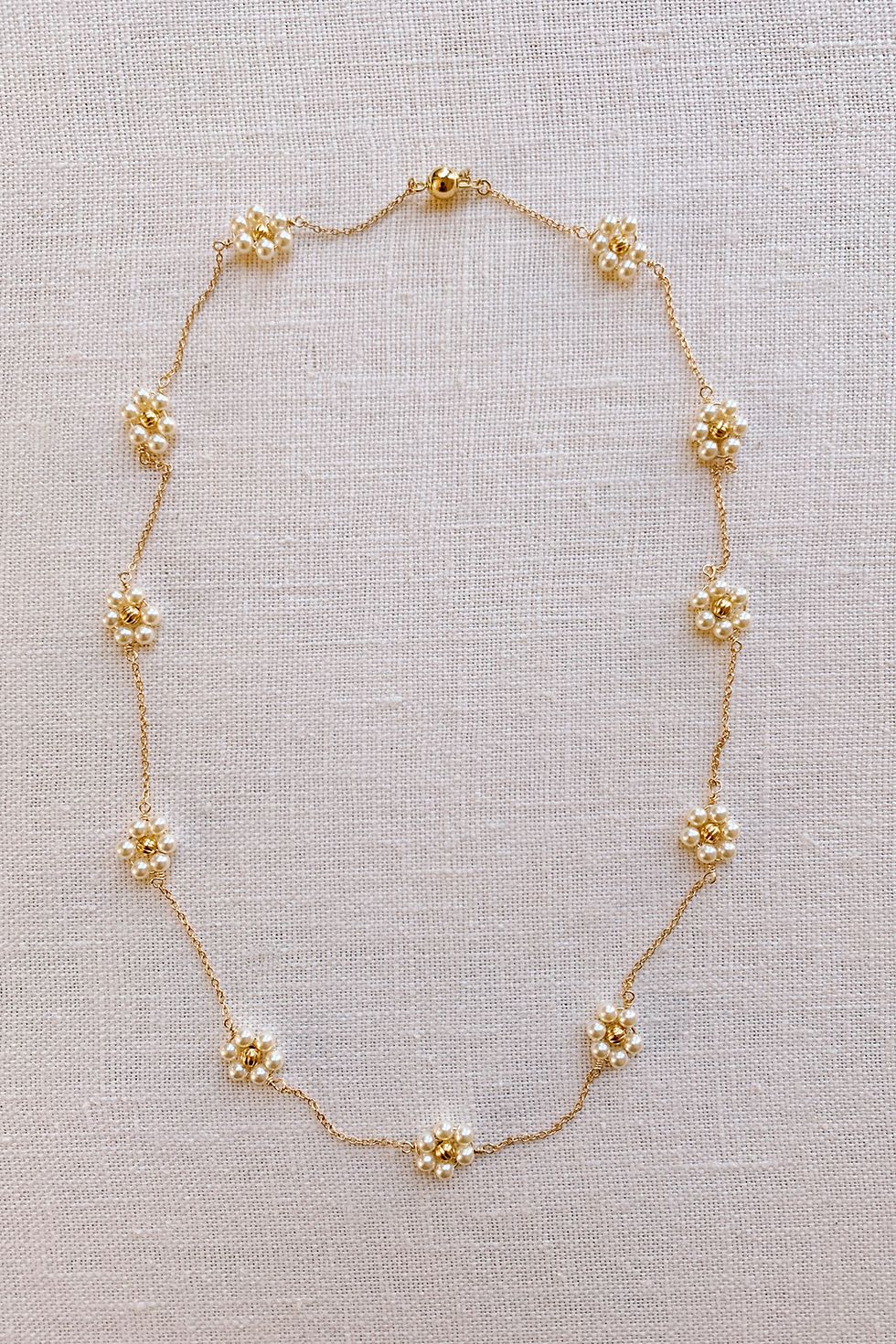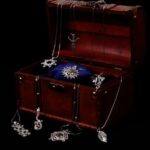Fashion jewelry has become increasingly popular in recent years, with a growing demand for unique and trendy pieces. As a result, selling fashion jewelry has become a lucrative opportunity for entrepreneurs and designers alike. The market is filled with potential for profitable sales, making it essential for sellers to know where to best showcase and sell their products.
In this article, we will delve into the various avenues available for selling fashion jewelry. We will explore online platforms such as Etsy, eBay, and Amazon that unleash the power of e-commerce. Additionally, we will discuss the potential of social media platforms like Instagram, Facebook, and Pinterest for attracting customers and maximizing sales.
Furthermore, we will look into the option of tapping into local boutiques that are open to selling fashion jewelry through consignment or wholesale deals. Participating in craft fairs, trade shows, or pop-up shops can also provide an excellent opportunity to captivate customers in person. For those looking for niche platforms dedicated solely to fashion jewelry, we will introduce specialized online marketplaces like Ruby Lane and CrateJoy.
Lastly, we will explore the advantages of creating personal online stores through platforms such as Shopify or Wix. Building an independent online store allows sellers to embrace autonomy and flexibility while optimizing product listings and implementing effective marketing strategies. Finally, we will discuss the impactful world of influencer marketing and how collaborations with influential individuals can inspire buyers to purchase fashion jewelry.
By navigating this landscape of opportunities with creativity and adaptability, sellers can truly make their mark in the lucrative market for fashion jewelry sales.
Online Marketplaces
Online markets have revolutionized the way fashion jewelry is sold, opening up a world of opportunities for sellers to reach a global audience. Renowned online platforms such as Etsy, eBay, and Amazon are powerful tools that can be leveraged to maximize sales and exposure.
Setting up an attractive online store is crucial to stand out in the competitive market. When creating a store on these platforms, it is important to consider the following tips:
- Design: Choose a visually appealing layout and theme that aligns with your brand image. Use high-quality product images and provide detailed descriptions for each item.
- Pricing: Research the market to ensure competitive pricing while still making a profit. Consider offering special promotions or discounts to attract customers.
- Customer Experience: Provide excellent customer service by promptly responding to inquiries and shipping orders in a timely manner.
- Rating and Reviews: Encourage satisfied customers to leave positive reviews, as this will help build trust with potential buyers.
- Search Engine Optimization (SEO): Optimize your product listings using relevant keywords in titles, descriptions, and tags to improve visibility in search results.
- Social Media Integration: Connect your online store with your social media accounts to reach a wider audience and drive traffic back to your store.
In addition to these tips, maximizing sales on online marketplaces requires active promotion of your products through various marketing strategies such as email campaigns, social media advertising, and influencer collaborations.
Selling fashion jewelry on online marketplaces offers immense potential for success due to the vast number of users they attract from all over the world. By taking advantage of these platforms’ features and leveraging effective marketing techniques, sellers can tap into the power of e-commerce and greatly expand their reach within the fashion jewelry industry.
Social Selling
Social media has become a powerful tool for businesses to connect with their target audience and sell their products. When it comes to selling fashion jewelry, platforms like Instagram, Facebook, and Pinterest offer endless opportunities to showcase designs, engage with customers, and drive sales. With the right strategies in place, social selling can be a lucrative avenue for fashion jewelry sellers.
To effectively utilize social media platforms for selling fashion jewelry, it is important to create engaging content that resonates with the audience. This can include high-quality product photos, videos showcasing the jewelry in action, behind-the-scenes glimpses of the design process, and customer testimonials. By curating an aesthetically pleasing feed or board that aligns with the brand’s identity and target market preferences, sellers can attract more followers and increase the likelihood of converting them into customers.
In addition to organic content creation, social media advertising is another valuable tool for reaching a wider audience. Platforms like Facebook Ads and Instagram Ads allow sellers to target specific demographics based on factors like age, location, interests, and purchasing behavior. Running targeted ad campaigns can help increase exposure for fashion jewelry products and drive traffic directly to an online store or product listing.
| Platform | Monthly Active Users | Demographics | Tips for Successful Selling |
|---|---|---|---|
| 1 billion+ | Mainly younger users (18-34) | – Utilize visually appealing content
| |
| 2.8 billion+ | Diverse user base across different age groups | – Create a Facebook Business Page
| |
| 478 million+ | Mainly female users; popular among millennials and Gen Z | – Create visually appealing pins highlighting your jewelry
|
By leveraging social media platforms effectively, fashion jewelry sellers can tap into a large and engaged online audience, boost brand visibility, foster customer relationships, and ultimately drive sales. It is essential to adapt strategies based on each platform’s unique features and the target audience’s preferences. Through consistent effort, creativity, and engagement, social selling can become a powerful avenue for success in the fashion jewelry industry.
Local Boutiques
Local boutiques have long been a go-to destination for fashion enthusiasts seeking unique and trendy pieces. As a fashion jewelry seller, tapping into the influence of these fashionable stores can be a valuable opportunity to showcase and sell your products. By identifying local boutiques that align with your target audience and negotiating consignment or wholesale deals, you can expand your reach and increase sales.
Identifying the Right Boutiques
Before approaching boutique owners, it is essential to research and identify the right stores that fit well with your brand and style of fashion jewelry. Consider factors such as the boutique’s aesthetic, target audience, and the types of products they already carry. Look for stores that have a similar customer base or whose customers would likely be interested in your jewelry.
Additionally, pay attention to the boutiques’ values and mission. If sustainability is an important aspect of your brand, seek out stores that prioritize ethical fashion. It is crucial to find boutiques that align with your values to ensure a successful partnership.
Approaching Boutique Owners
Once you have identified potential boutiques, it’s time to approach their owners or managers. Craft a professional and compelling email or reach out in person if possible. Start by introducing yourself and your brand, highlighting what makes your fashion jewelry unique and appealing.
In your communication, emphasize the potential value you can bring to their store through increased foot traffic, new customers, or complementary product offerings. Offer specific details about which pieces from your collection would be a good fit for their boutique based on their existing inventory.
Consider suggesting consignment or wholesale options based on what works best for both parties involved. Consignment allows you to retain ownership of the jewelry until it sells while wholesale involves selling upfront at a lower price point but without ownership responsibility. Be open to negotiations and flexible in finding mutually beneficial terms for collaboration.
Remember that building relationships with boutique owners takes time; don’t get discouraged if some boutiques decline initially. Learn from each interaction and refine your approach to improve your chances of success in future collaborations.
By tapping into the influence of local boutiques, fashion jewelry sellers can reach new customers and expand their brand presence. With careful research, strategic targeting, and effective communication, partnering with fashionable stores can be a lucrative avenue for selling fashion jewelry.
Craft Fairs and Pop-Up Shops
Craft fairs and pop-up shops provide an excellent opportunity for fashion jewelry sellers to connect with customers in person. These events attract a diverse range of shoppers who are specifically interested in unique and handmade products. Participating in craft fairs, trade shows, or pop-up shops can help fashion jewelers showcase their creations, build brand awareness, and engage with potential buyers on a more personal level.
Benefits of Participating
Craft fairs and pop-up shops offer several advantages to fashion jewelry sellers. Firstly, these events allow sellers to create a visually appealing display that can attract the attention of passersby. By showcasing their jewelry in an attractive and eye-catching manner, sellers have the opportunity to draw potential customers towards their booth.
Secondly, participating in craft fairs and pop-up shops provides the chance to interact directly with customers. This face-to-face interaction allows sellers to answer questions, provide recommendations, and share the story behind their jewelry. Building this personal connection can greatly enhance the customer’s experience and increase the likelihood of making a sale.
Lastly, craft fairs and pop-up shops often attract individuals who actively seek out unique and handcrafted items. These shoppers appreciate the craftsmanship and creativity behind fashion jewelry, making them more likely to make a purchase. Selling at these events helps target a niche audience that is already inclined towards supporting independent artisans.
Maximizing Sales Potential
To capture the attention of customers at craft fairs and pop-up shops, it is important for fashion jewelry sellers to effectively showcase their products. Consider implementing these strategies:
- Eye-catching display: Invest in visually appealing displays that reflect the brand aesthetic or theme of the jewelry collection being sold.
- Engaging signage: Use clear signage that highlights key features or benefits of the jewelry pieces.
- Interactive elements: Incorporate interactive elements such as try-on stations or demonstrations to encourage customer engagement.
- Special offers: Offer exclusive discounts or promotions at the event, creating a sense of urgency and encouraging immediate purchases.
- Knowledgeable staff: Ensure that booth representatives are well-informed about the jewelry and can confidently answer questions from potential customers.
In addition to attracting customers during the event, it is important to have a plan for follow-up after the craft fair or pop-up shop ends. Collect contact information from interested attendees, such as email addresses or social media handles, and send them personalized thank-you notes or promotional offers to encourage future sales.
Participating in craft fairs and pop-up shops provides an exciting opportunity for fashion jewelry sellers to showcase their creations and connect with customers on a personal level. By designing an attractive display, engaging with shoppers, and implementing post-event follow-up strategies, sellers can make the most of these in-person selling experiences.
Online Marketplaces Dedicated to Fashion Jewelry
In addition to popular online platforms like Etsy, eBay, and Amazon, there are several niche marketplaces that specialize in fashion jewelry. These platforms can provide maximum exposure and a targeted audience for selling your unique pieces. Two notable examples of these specialized online marketplaces are Ruby Lane and CrateJoy.
Ruby Lane is a highly respected platform that focuses on antiques, collectibles, art, and fashion jewelry. With its emphasis on vintage and high-quality items, Ruby Lane attracts a specific demographic of buyers who appreciate the craftsmanship and uniqueness of fashion jewelry. By selling on Ruby Lane, artisans can tap into a community of dedicated collectors and enthusiasts who are eager to discover and purchase one-of-a-kind pieces.
CrateJoy is another niche platform that caters specifically to subscription boxes. While not exclusively focused on fashion jewelry, CrateJoy offers an opportunity for designers to curate themed boxes containing their pieces along with other complementary items.
This approach allows designers to showcase their work in a curated collection that appeals to customers looking for surprises and new trends. By participating in subscription boxes on CrateJoy, artisans can gain exposure to a wider customer base while maintaining control over how their jewelry is presented.
Selling on niche platforms like Ruby Lane and CrateJoy can be advantageous because they attract customers who are actively seeking out unique fashion jewelry. However, it’s important to consider the challenges that come with these platforms as well. Competition can be fierce among sellers, so it’s crucial to carefully curate your product listings with high-quality images and detailed descriptions.
Additionally, these platforms may charge listing fees or take a percentage of each sale as commission. Sellers should weigh these factors against the potential benefits when deciding whether or not to sell on niche marketplaces.
Overall, exploring online marketplaces dedicated to fashion jewelry can provide maximum exposure for your designs within targeted communities. By considering the unique features of platforms like Ruby Lane and CrateJoy, artisans can find new opportunities to connect with enthusiastic buyers and expand their customer base.
Creating Personal Online Stores
In today’s digital age, creating a personal online store has become an increasingly popular option for those looking to sell fashion jewelry. Building an independent online store allows sellers to have complete control over their brand, product listings, and customer experience. With platforms like Shopify or Wix, setting up an online store has never been easier.
One of the key advantages of having a personal online store is the autonomy it offers. Sellers can design the layout, choose the color scheme, and create a unique brand image that aligns with their vision and target audience. This level of customization helps to differentiate the store from competitors and establish a strong brand identity.
Optimizing product listings is crucial in attracting potential customers to your online store. High-quality product images coupled with detailed descriptions and accurate measurements can significantly increase your chances of making a sale. Additionally, incorporating customer reviews and ratings can provide social proof and build trust among visitors. Offering secure payment options and clear shipping policies can further enhance the buying experience.
To drive traffic to the online store, implementing effective marketing strategies is essential. Utilizing social media platforms such as Instagram, Facebook, and Pinterest can help create brand awareness and engage with potential customers. Posting visually appealing content featuring your fashion jewelry establishes credibility as well as encourages sharing within these communities.
| Advantages | Challenges |
|---|---|
| – Complete control over brand image | – Developing a marketing strategy to drive traffic |
| – Customization options for design | – Managing inventory and logistics |
| – Direct interaction with customers | – Building trust and credibility without in-person interactions |
Collaborations with Influencers
Collaborations with influencers have become an increasingly popular strategy for promoting and selling fashion jewelry. Influencers, who are individuals with a significant following and influence on social media platforms and blogs, can inspire buyers and drive sales through their recommendations and endorsements. By leveraging the influence of these fashion-forward individuals, sellers can reach a wider audience and build trust among potential customers.
When it comes to collaborating with influencers, it’s important to choose individuals who align with the brand’s image and target audience. Finding influencers who have an established following in the fashion or jewelry niche ensures that their recommendations will resonate with their followers. Additionally, considering factors such as engagement rates, demographics of the influencer’s audience, and previous collaborations can help determine if a particular influencer is a good fit for promoting fashion jewelry.
Reaching out to influencers can be done through direct messages on social media platforms or through email contact provided on their profiles or websites. When approaching an influencer, it’s crucial to personalize the message and explain how the collaboration can benefit both parties. Offering free samples or exclusive discounts to the influencer’s followers is often an effective way to incentivize them to promote the jewelry.
Once a collaboration is established, it’s essential to provide clear guidelines and expectations for promoting the fashion jewelry. This may include specific hashtags or keywords to use in social media posts, incorporating photos or videos showcasing the jewelry in various outfits or styling tips, or even hosting giveaways or discount codes exclusively for the influencer’s followers.
Conclusion
In conclusion, the fashion jewelry industry presents a lucrative market for those looking to sell their products. With the growing popularity and demand for fashion jewelry, there are numerous avenues available to explore. Online marketplaces such as Etsy, eBay, and Amazon offer a convenient platform for reaching a wide audience and maximizing sales potential. By setting up an attractive online store and utilizing effective marketing strategies, sellers can optimize their presence on these platforms.
Social media platforms like Instagram, Facebook, and Pinterest also offer immense potential for selling fashion jewelry. Through engaging content creation and targeted social media advertising, sellers can reach a wider audience and generate more leads. Furthermore, collaborating with influencers in the fashion industry can inspire buyers and drive sales.
Local boutiques and specialty stores serve as another avenue for selling fashion jewelry. By identifying boutiques that are open to consignment or wholesale deals, sellers can tap into the influence of fashionable physical stores.
Craft fairs, trade shows, and pop-up shops provide an opportunity to captivate customers in person. Effectively showcasing the jewelry, attracting customers with eye-catching displays, and providing exceptional customer service can turn sales into loyal customers.
Additionally, there are niche platforms dedicated specifically to fashion jewelry such as Ruby Lane and CrateJoy. These specialized online marketplaces can offer maximum exposure to a target audience interested in fashion accessories.
For those seeking autonomy and flexibility, building an independent online store using platforms like Shopify or Wix is a viable option. By enhancing the store’s brand image, optimizing product listings, and implementing effective marketing strategies, sellers can create a unique shopping experience for their customers.
In navigating the fashion jewelry selling landscape, it is important to note that experimentation is key. Sellers should be open to trying different approaches and learning from their experiences to find the most successful strategy for their business.

Welcome to my jewelry blog! My name is Sarah and I am the owner of this blog.
I love making jewelry and sharing my creations with others.
So whether you’re someone who loves wearing jewelry yourself or simply enjoys learning about it, be sure to check out my blog for insightful posts on everything related to this exciting topic!





